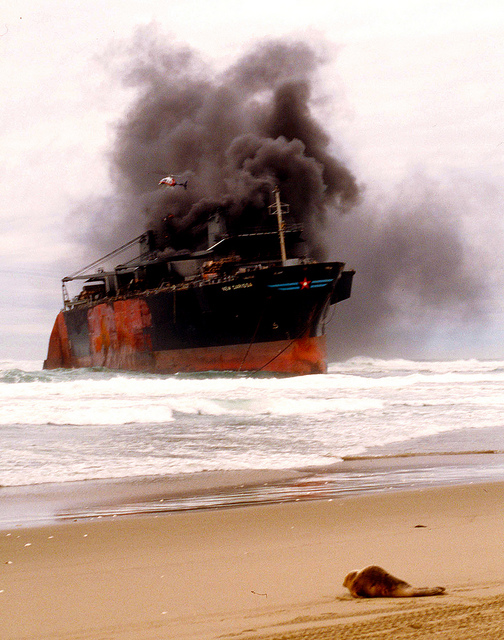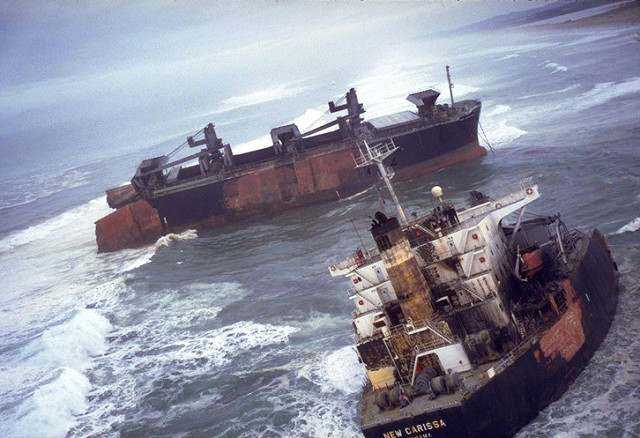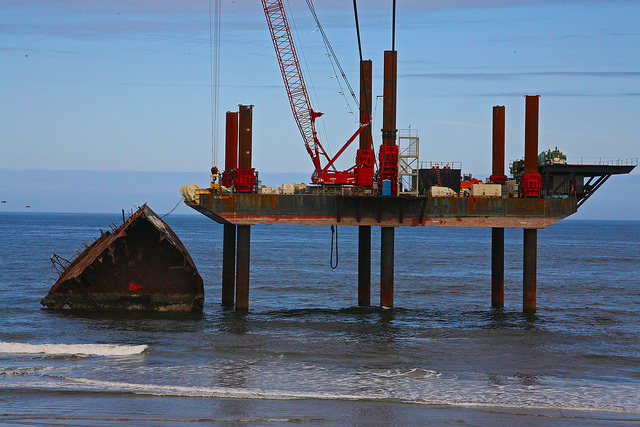The New Carissa, a 639-foot freighter, wrecked on the North Spit near North Bend early on the morning of February 4, 1999, causing what many experts consider Oregon’s worst oil spill disaster. High winds and twenty-six-foot swells drove the ship aground south of Horsefall Beach, about 2.7 miles north of the jetty. The twenty-three-man crew was rescued by mid-day, but re-floating the ship proved more difficult, as the storm continued to push the New Carissa deeper into the sands and kept rescue ships bottled up at nearby ports.
Even though the cargo hull of the freighter was essentially empty, rescuers were concerned about the 400,000 gallons of fuel oil on board. Over 70,000 gallons leaked onto local beaches and estuaries, causing the death of over 3,000 shorebirds and threatening many marine-based businesses. Attempts made to pump off the fuel were unsuccessful, so the decision was made to burn the New Carissa to get rid of what remained. This type of operation had never been tried before in the contiguous United States.
On February 11, crowds of people from North Bend and Coos Bay watched the U.S. Navy set the explosives on the ship. Over half the fuel did burn, but the explosion and fire caused the New Carissa to split in half, leaving some fuel lodged in the bow.
By late February a decision was made to tow the bow section out to sea and sink it. As the freighter was being towed on March 2, a storm broke the towline. The bow of the New Carissa drifted back to shore and landed at Waldport. Luckily, little fuel oil was spilled.
By March 9 authorities were able to re-attach the towline and drag the bow 280 miles out to sea. Two days later, 380 pounds of plastic explosives were detonated on board. The bow refused to sink. The navy shot 70 rounds of shells at the bow, which still refused to sink. Finally, a torpedo directly hit the bow and sent it to its watery grave. The operation earned the New Carissa the nickname the Ship that Would Not Die.
The State of Oregon eventually won a court battle to have the stern of the ship removed from the beach. The removal project, conducted by Titan Maritime, was completed by the fall of 2008.
-
![]()
New Carissa Shipwreck, February 1999.
Courtesy Bureau of Land Management Oregon and Washington
-
![]()
New Carissa Shipwreck, 1999.
Courtesy Bureau of Land Management Oregon and Washington
-
![]()
Remains of New Carissa Shipwreck, 2008.
Courtesy Bureau of Land Management Oregon and Washington
Related Entries
-
![New Carissa trials]()
New Carissa trials
A 639-foot freighter, the New Carissa, ran aground in inclement weather…
-
![The Wreck of the Congress (ship)]()
The Wreck of the Congress (ship)
The rescue of all 445 people aboard the burning passenger steamer Congr…
Map This on the Oregon History WayFinder
The Oregon History Wayfinder is an interactive map that identifies significant places, people, and events in Oregon history.
Further Reading
Dresbeck, Rachel. Oregon Disasters: True Stories of Tragedy and Survival. Kearney, Nebr.: Morris Book Publishing, 2006.




